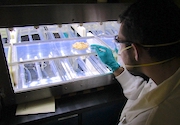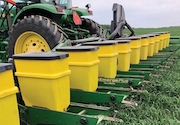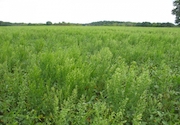| |
| |
 |
| |
 |
|
Dec. 25, 2018 |
|
| |
Late season rains increased ear mould issues and DON levels in grain corn. Mycotoxins in corn had not been this high since 2006, and resulted in the Ontario and federal government stepping in to help producers who had been affected.
» Read more...
Not only was this one of our top stories, but the discovery of genetically modified wheat in Alberta also made national news headlines, bringing up concerns about biosecurity and the commercial implications for Canadian wheat shipments.
» Read more...
At the end of the summer, Health Canada announced its plan to phase out most uses of the neonicotinoids, clothianidin and thiamethoxam, citing harm to aquatic insects. The consultation period has wrapped, but the impending decision will impact yields and increase risks faced by growers.
» Read more...
Hormones play a critical role in how plants respond to factors, including sunlight, soil conditions, soil water and nutrients. Hormones are naturally occurring in plants, but some specific hormones can be made synthetically for application to crops.
» Read more...
|
| |
 |
| |
|
| |
 Is there a light at the end of the tunnel that can help reduce toxins like DON in harvested cereals? A recent feasibility study is pointing to ultraviolet light as new option for reducing fungi and fungal toxins on corn and wheat kernels.
» Learn more
Is there a light at the end of the tunnel that can help reduce toxins like DON in harvested cereals? A recent feasibility study is pointing to ultraviolet light as new option for reducing fungi and fungal toxins on corn and wheat kernels.
» Learn more |
| |
 Will eastern provinces catch up to the west’s enthusiasm for intercropping? Good news stories from Western Canadian farmers about the many benefits of intercropping have made their way to Ontario, resulting in a three-year wheat-soybean intercropping trial
» Learn more
Will eastern provinces catch up to the west’s enthusiasm for intercropping? Good news stories from Western Canadian farmers about the many benefits of intercropping have made their way to Ontario, resulting in a three-year wheat-soybean intercropping trial
» Learn more |
| |
 With a new herbicide registered for Canada fleabane control, the options to control glyphosate-resistant Canada fleabane are growing. Peter Sikkema from the University of Guelph investigated tank mixes and preplant burndown options to control the weed.
» Learn more
With a new herbicide registered for Canada fleabane control, the options to control glyphosate-resistant Canada fleabane are growing. Peter Sikkema from the University of Guelph investigated tank mixes and preplant burndown options to control the weed.
» Learn more |
| |
|
| |
|
|
| |
| |





